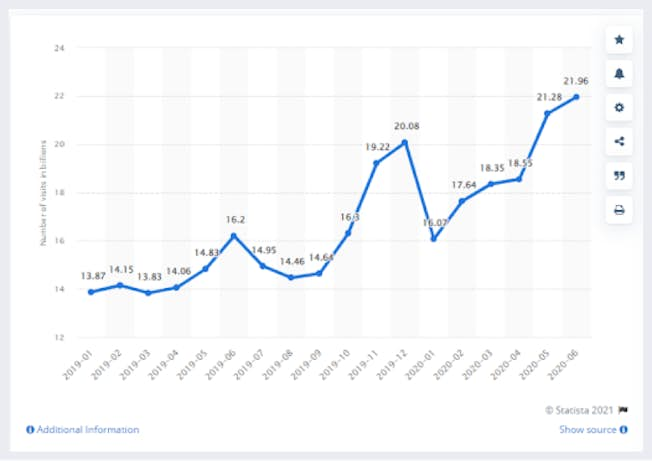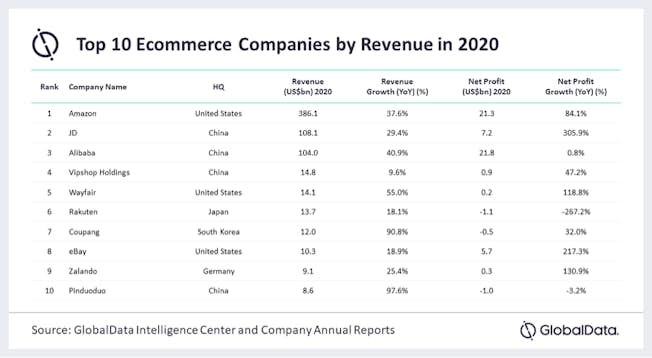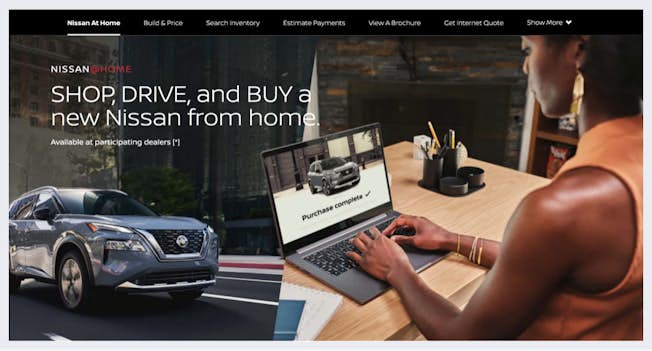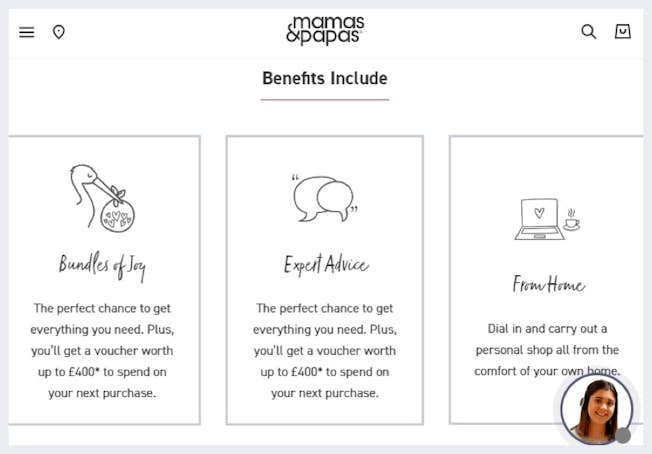The Covid-19 pandemic changed everything, from the way people seek information, communicate, and even purchase. These changes mean that brands have to rethink how they market to customers and find new ways to build loyalty.
In tandem, the way people work in companies was radically altered. The days of 9 to 5 in the office are gone, to be replaced by remote and hybrid working. This drastic change has forced companies to reassess how teams can communicate and work together to drive business success.
So, how have brands been learning to cope with Covid-19 and what impact does it have on the digital marketing activities of today and tomorrow? Our findings reveal 6 significant developments that companies need to consider as they strive to thrive in a post-pandemic world.
1. Ecommerce is crucial to brand success
As a result of the Covid-19 pandemic, global retail e-commerce sales rose to nearly $4.28 trillion with nearly $432 billion of that being generated in the United States. Between 2019 and 2021 (the peak of Covid-enforced lockdowns), retail platforms - according to Statista - reported a surge of 22 billion visits in June up from 16 billion visits just five months earlier, in January.

In the UK, Charged Retail reported that online sales broke records by reaching £10 billion in July 2021 as 40% of people chose to shop from home rather than visit a physical store despite the end of lockdown. In Q2 2021, Shopify revealed it reached its first $1 billion in a quarter on record with its Gross Merchandise Volume (GMV), up 57% year-on-year.
And, Shopify isn’t the only company to benefit. GlobalData research revealed that 90% of the top ten ecommerce sites such as Amazon and Alibaba saw double-digit revenue growth. This was due to an increase in the number of people visiting online retail platforms as a result of Covid.

And this trend in online retail shopping is continuing, even after the introduction of mass vaccinations, and a shift to more normal life. Many countries are still experiencing huge spikes with Deloitte predicting that U.S holiday retail sales in late 2021 will increase by 7 to 9% while in South-East Asia, ecommerce penetration will grow by 85%, outpacing India (+10%) and China (+5%) and digital consumer spend in this region will increase by 60% by the end of 2021.
Whether it’s directly on your brand’s website, through social media or a third-party site such as Amazon or Shopify, optimizing your brand’s ecommerce offering will lead to more leads and sales in this new digital world.
2. Sectors need to pivot and reinvent
Due to the nature of their businesses, certain sectors benefited more than others during lockdowns: for example, hospitality and tourism unsurprisingly saw their profits plummet.
What became apparent was the importance of being able to think outside the box when external factors come into play. Customers with no option to buy what they needed online just went to another site or brand.
Retail
An example of this was retail chain Primark, who lost $1 billion during the pandemic by not adopting an ecommerce model. While customers said they would welcome an online shop, Primark stated that the cost of setting up an online function would affect the prices they could offer customers. The bottom line? Primark was not prepared logistically for such an undertaking and starting an ecommerce site would have cost time and money.
Other retailers also suffered, changing the landscape of the high street forever. As a result of store closures, the Arcadia Group became insolvent and was bought by online retailer Asos for £65 million for its stock and brands, not for its physical stores, which included the UK high street icons, Topshop, Topman, and Miss Selfridge.
On the flip side of the fashion coin, resale platforms for secondhand clothing like Depop have flourished as people look to sell unworn or unwanted clothes. As buyers become more aware of the lifespan and journey of what they purchase, customers that value sustainability are preferring to buy clothing differently.
Another outcome of the pandemic has been one inspired use of TikTok and its direct effect on the publishing industry. Thanks to the organic success of the #BookTok concept, newer (and younger) audiences are being introduced to the joys of reading paper books and bricks-and-mortar bookshops have been responding by laying out displays based on what’s popular in the online platform.
Automotive Industry
The car industry also took a significant hit during the pandemic as it is traditionally low tech and has been slow to digitally transform. With no foot traffic into showrooms, the industry has had to find other ways to sell cars as people were forced to stay at home. To draw customers in, many installed new software, offered virtual test drives, and touchless pickup and delivery. Many also leveraged digital strategies to engage with new and existing customers online.
Big brands are taking that even further with Nissan launching its online experience Nissan@Home to buy a car from test drive to contracts signing all from home. While one of the largest automotive dealers in the U.S, Sonic Automotive has hired its first CDO and VP of Ecommerce to double annual revenue by 2025.

It’s obvious that in a post-pandemic world, brands need to be willing to change and reimagine their business model to survive and attract customers.
3. Local vs. global marketing - The value of community
Travel restrictions due to the pandemic resulted in people staying in their localities. This made local neighborhoods more valuable to people and built a sense of community reinvigorating areas that had once been neglected in favor of cities.
On Google Search, the keywords ‘local’ and ‘business’ were up 80% while the combination of ‘who has’ and ‘stock’ went up by a whopping 8,000%! Staying local meant shopping local (or #shoplocal).
This shift required marketers to talk to customers in different ways and focus on localizing content and message. A great example of this is Nextdoor, a social media network that focuses on neighborhoods. During different lockdowns, the channel saw a 73% rise in engagement alongside a jump in revenue as marketers flocked to connect with customers on a local level.
This just demonstrates the complexity involved in the future of search marketing as brands need to be on top of what customers are looking for.
A recent Facebook survey revealed a surge in online community groups during Covid. 91% of people have provided support to others through an online group or community, while 98% felt a sense of belonging by being part of a group. This new reliance on and trust in online communities provides marketers with an opportunity to connect with niche audiences in a meaningful way to build a loyal community base.
4. Paid search and brand marketing need to combine forces
Marketers love paid search activity (also known as performance marketing) as it’s easy to measure your return on investment (ROI) and makes it simpler to identify campaigns that work, and those that don’t. Whether it’s through native advertising, social media advertising, sponsored advertising or affiliate marketing, brands can link spending to an action such as a lead, sale or click.
Brands tend towards paid search marketing using platforms such as Google, Amazon, and Facebook as it offers a cost-effective way to target the right customers. The surge in online traffic during Covid-19 meant that more brands turned to online channels to engage with customers. This created a competitive environment and forced many marketing teams to reevaluate how to get the most return for their budgets. After all, global spending on advertising according to Statista is set to reach $790 billion in 2022.
A huge shift in consumer behavior as a result of the pandemic has been a need for brands to demonstrate humanity and trust, according to Deloitte’s Human Values Compass. Customers now want to know more about the companies they buy from and what they stand for which feeds into a need for heightened brand awareness. This has become particularly important for social issues as consumers become more conscious of buying from brands that have a social conscience and want to make the world a better place.
In a bold move, Airbnb shifted its budget away from paid search marketing to focus on brand marketing, particularly PR. This shift was due to their obvious need (as a travel brand) to slash spending during Covid-19, but what they noticed during this time was that their website traffic levels bounced back to 95% of pre-Covid 2019 levels without any marketing spend.
Bear in mind that the public awareness of Airbnb’s brand enables them to pull back on performance marketing. The majority of companies don’t have that type of power. In an ideal world, a combination of paid and brand marketing will help you to get the most from your marketing budget and activities.
5. Customer experience is everything!
As people were forced to stay at home, they started to do things differently. While online behaviors changed, so did expectations. Customers expected more from brands and their online experience. If their expectations were not matched by a brand’s delivery, then they went elsewhere to find it and competition is fierce.
Customers want to feel valued so they expect a digital experience that treats them that way. Brands need to focus on providing solutions and answers through online chat capabilities or messaging using WhatsApp marketing. During the pandemic, consumers got used to new options such as curbside pick-up which has proved a success for retailers big and small. While many big chains partnered with delivery services such as Deliveroo to draw in customers.
As one of the major casualties of the pandemic, restaurants needed to pivot and find new ways to offer a great customer experience. Many thought outside the box to convert their restaurant into an online farm shop or ‘prepare at home’ options with video tutorials such as Minnesota bakery Cookie Cups. Many also relied on delivery apps, but the tide has started to turn as restaurants need to reduce their margins and have started an in-house delivery option making the future of the restaurant industry an interesting one to watch.

Creating unique experiences that help your customer can help your brand to stand out. To help new parents during the pandemic, Mamas & Papas developed a virtual personal shopping service to get advice and live product demonstrations. Another example is Urban Outfitters who use email consultations and virtual appointments for customers which resulted in a 25% hike in transactions.
6. Social Commerce is accelerating
Social media platforms are getting more sophisticated. No longer just a way to catch up with friends and share photos, many social networks are becoming the perfect place for brands to promote and sell their wares.
This is particularly true for younger generations as the Status of Social Commerce 2021 report found that 97% of Gen Z use social media as their top inspiration for shopping. With such activity on social media, brands would be foolish to not explore the option of an in-app purchase. After all, the global social commerce market is projected to reach $604.5 billion by 2027 making the future of social media marketing look very bright.
Shopping through social media sites - social commerce - has taken on a new life due to the coronavirus. Instagram launched Shops and Shopping in Reels while Facebook and TikTok now host livestream shopping events. Snapchat and Pinterest are also getting in on the action with Augmented Reality (AR) try-on tools with brands such as Gucci.
.png?fm=jpg&ixlib=php-3.3.1&q=40&w=652&s=b58896044e3907465691036a22f0b2eb)
When you talk about social commerce, you can’t ignore the power of influencers. Whether they have thousands or millions of followers, influencers have a lot of clout on social media and can earn a lot of money through sponsorship deals and promoted posts. Many brands are now engaging in influencer marketing to persuade people to make that final click to purchase.
By connecting your brand’s ecommerce to social media interfaces on Facebook and Instagram, you can target new customers. Check out this walkthrough shopping guide to find out how brands sell effectively on social networks.
The key to success for big and small businesses on social media in a post-Covid world is to put customers at the heart of your activities. Combining a great customer experience with a simple customer journey and messaging that humanizes your brand will make for a perfect digital marketing cocktail that generates leads and nurtures customers.
Tap into the potential of digital marketing
The change in online behavior means that companies need digital professionals with relevant and up-to-date skills. DMI’s Professional Diploma in Digital Marketing will provide you with the core skills required to succeed such as social research, digital strategy, email marketing, and social media marketing. The certification will also give you in-depth knowledge of specialized skills such as SEO, analytics, and display and video advertising. Enroll today to get your career on the right track.
Related
Upgrade to Power Membership to continue
your access to thousands of articles, toolkits, podcasts, lessons and much much more.
Become a Power Member- Login
- View Courses
- - - -
- Courses
- Resources
- - - -
- My Account
- Change Password
- Logout





